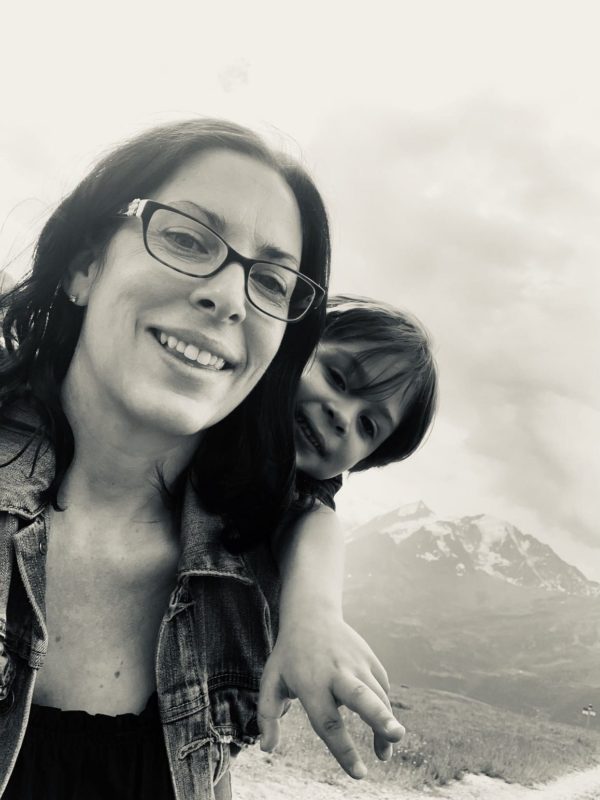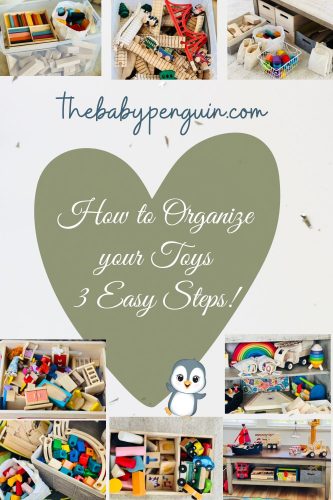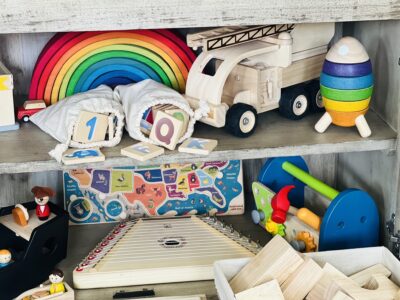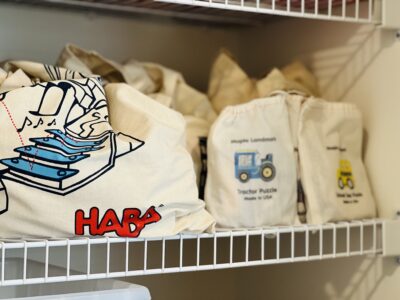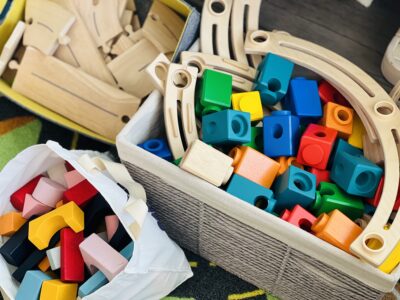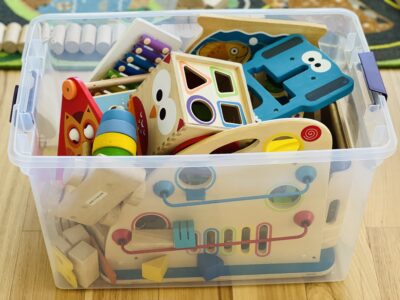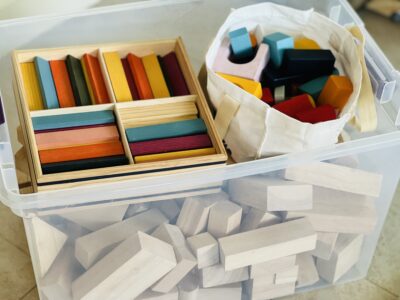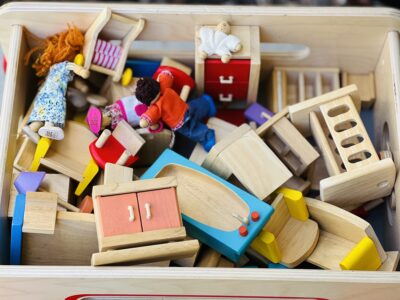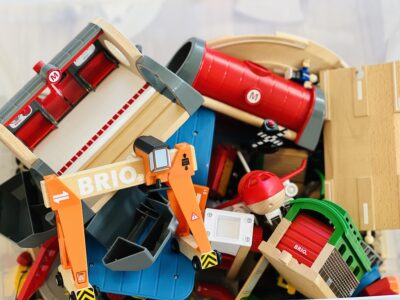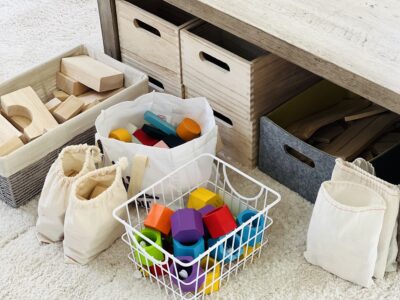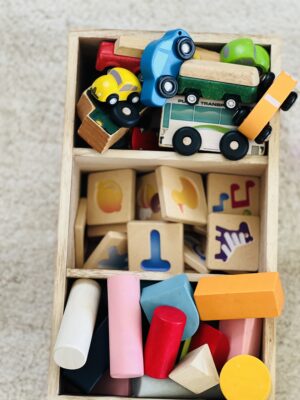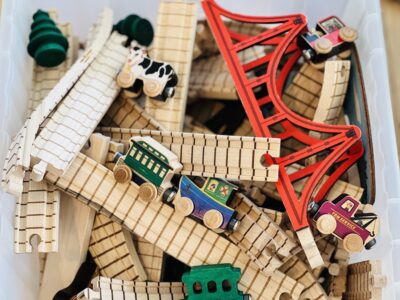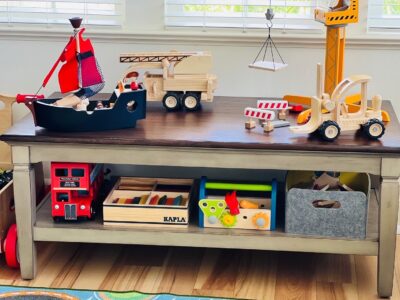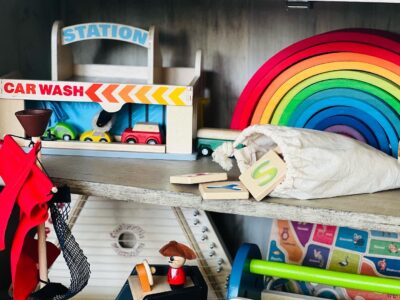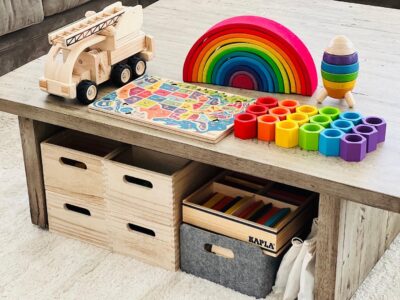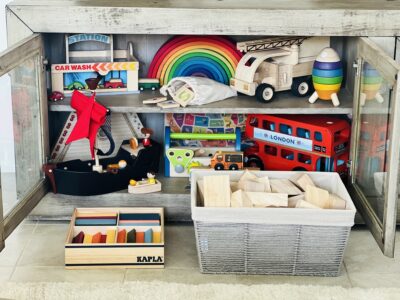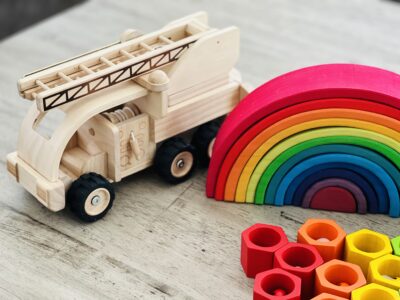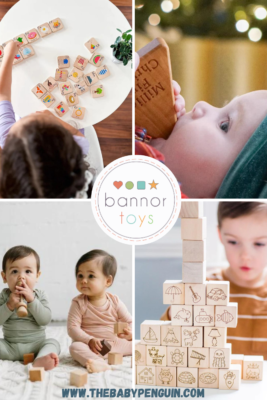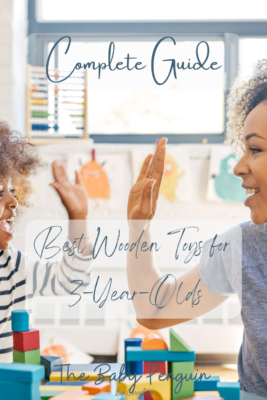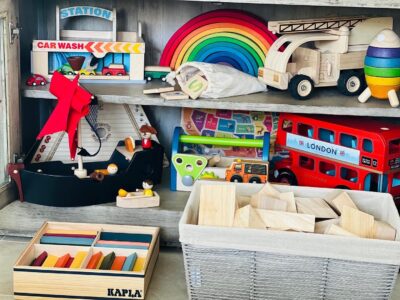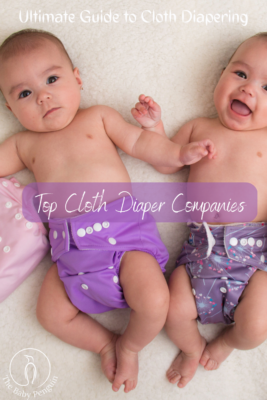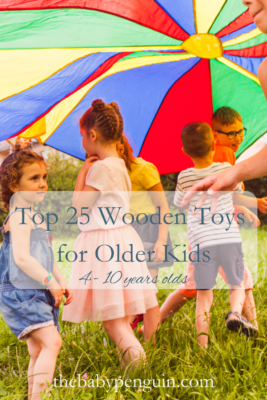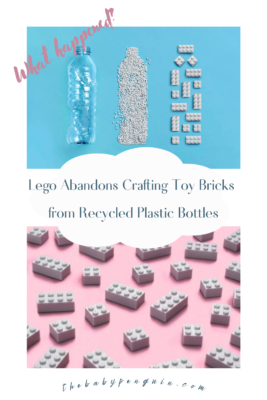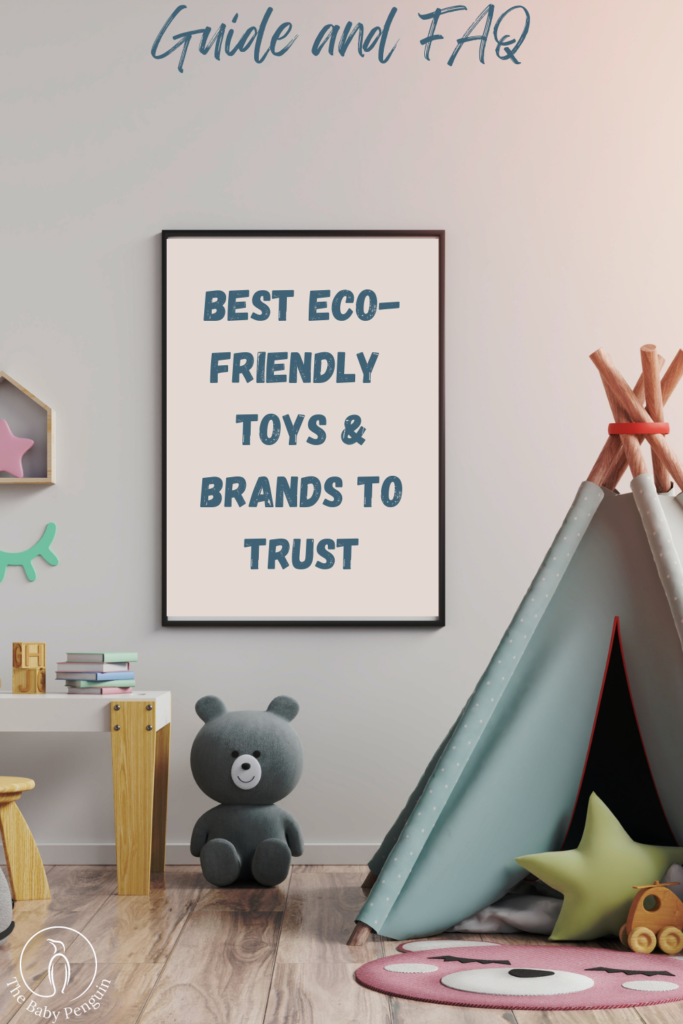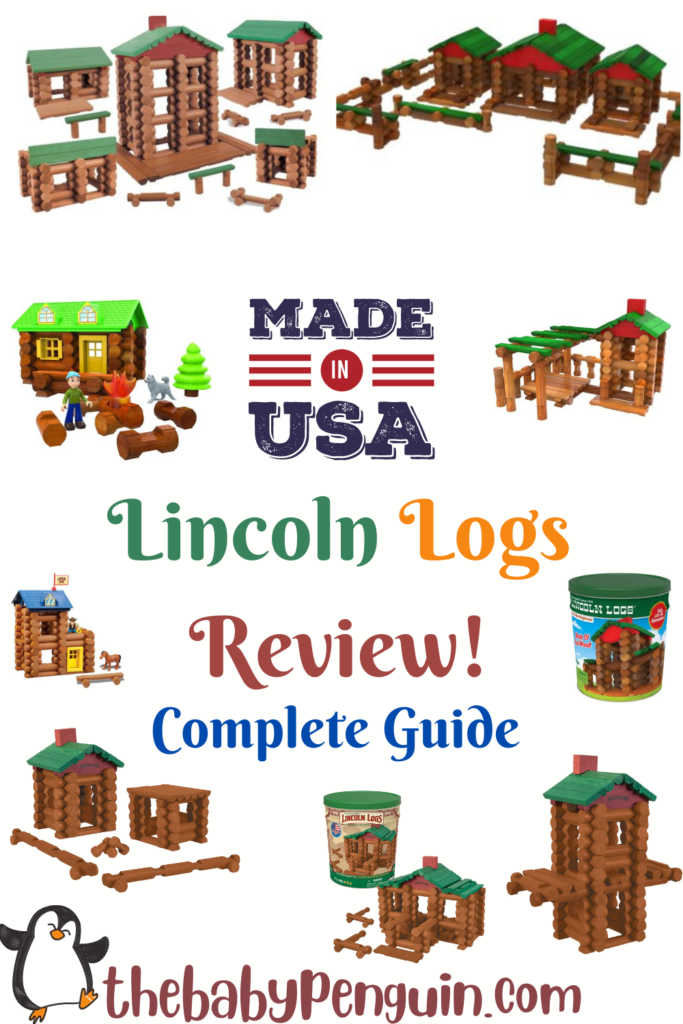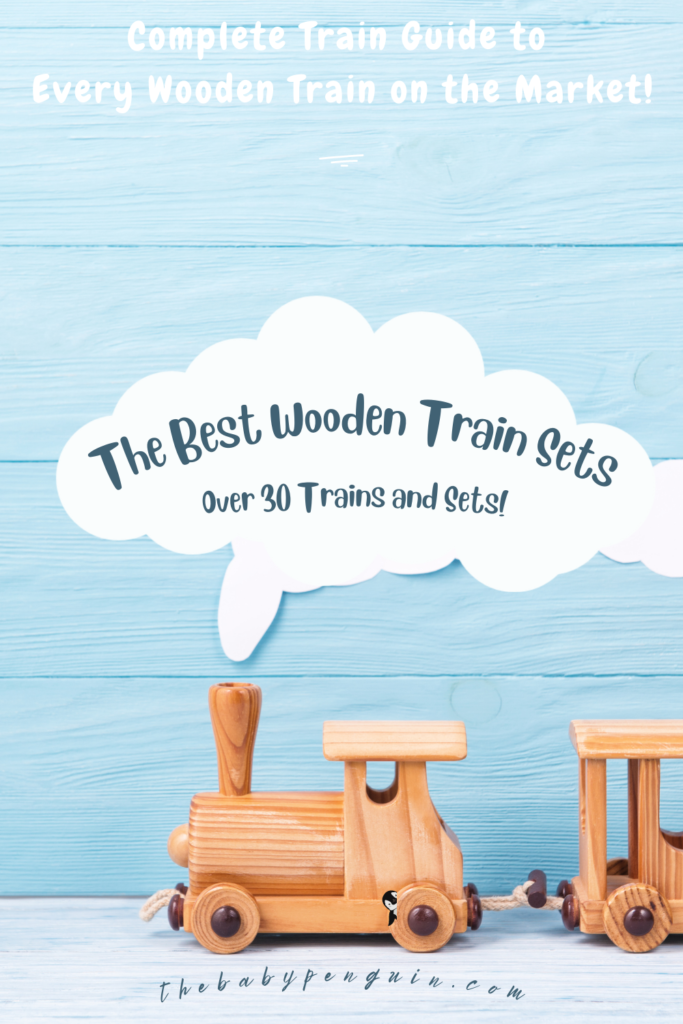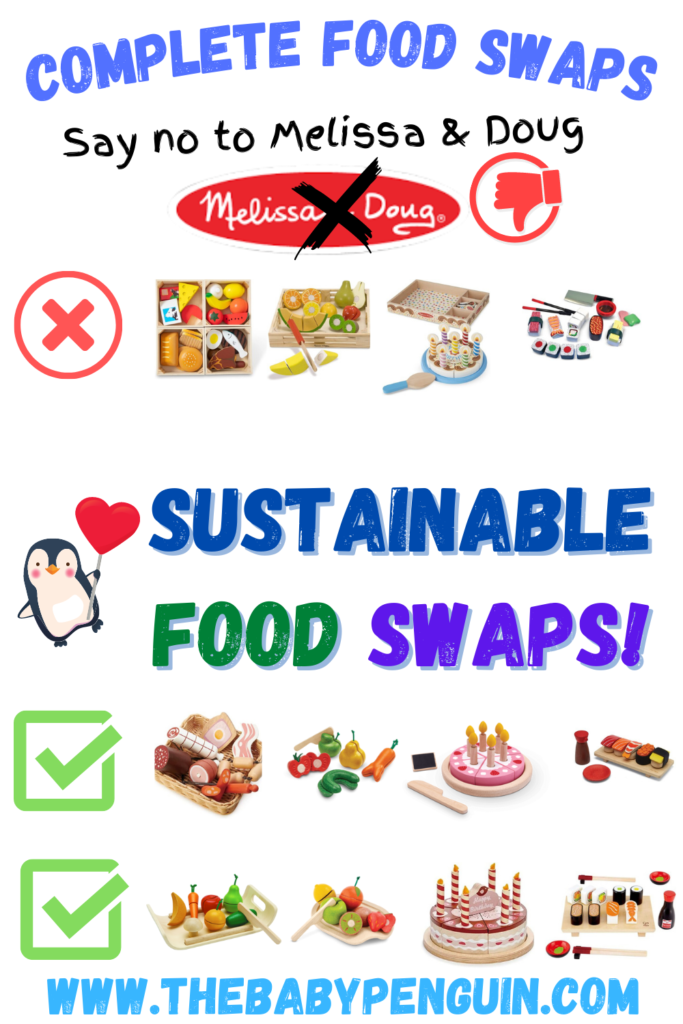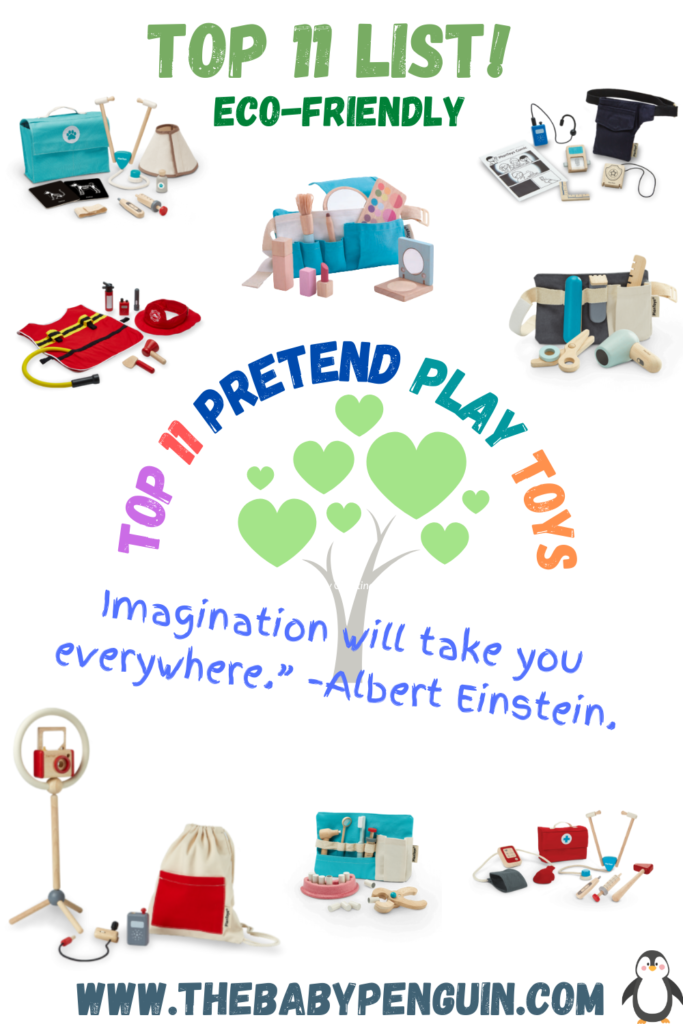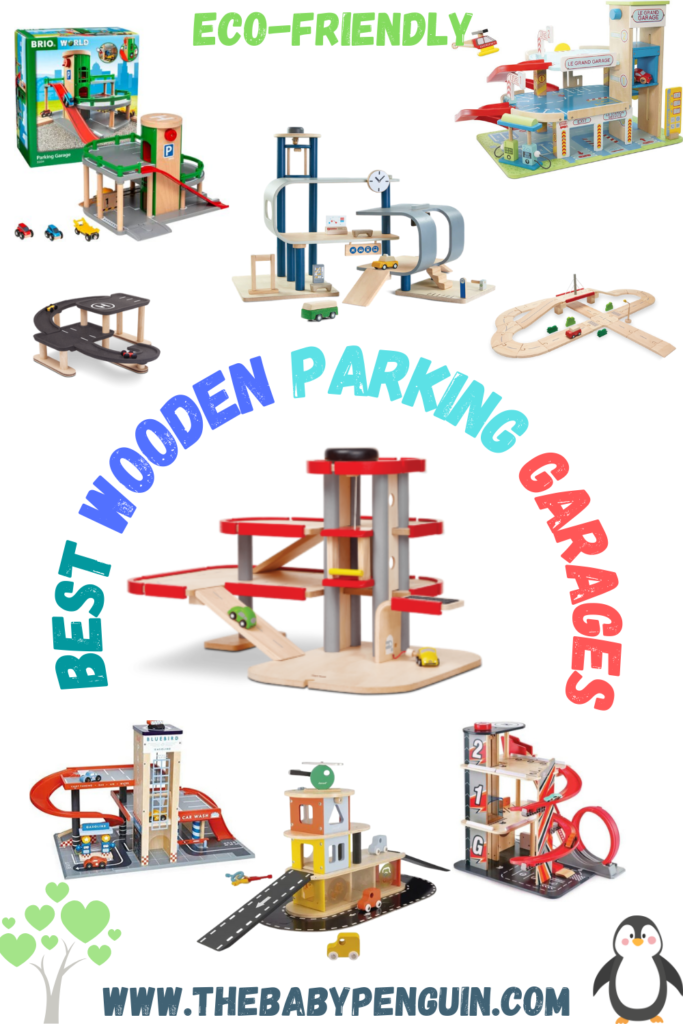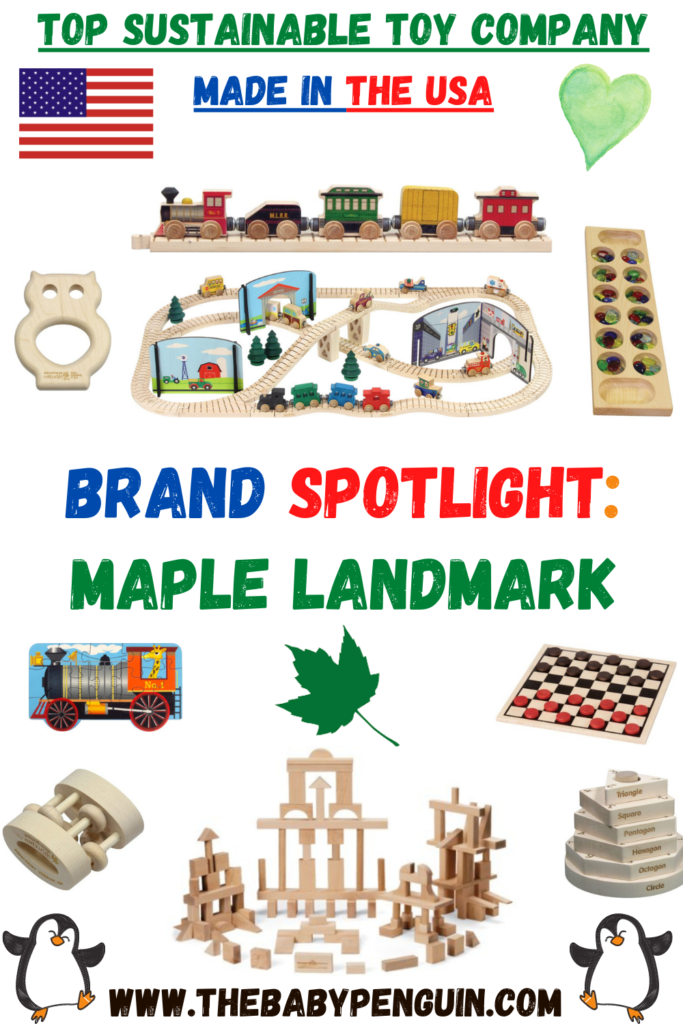Table of Contents
ToggleHow to Organize Toys in 3 Easy Steps!
How to Organize Toys in 3 Easy Steps is a great guide to help you declutter, store, and display all of the toys in your home! As a mother of 5 kids, I have quite a few years of experience with managing the toy mess around the house. I used to joke that my occupation was a toy curator, like a museum curator in charge of large collections. Through the years, I have tried many different toy organizing strategies but came to realize that they all ended up having to be constantly maintained and organized. Everyone knows that with kids come lots of toys. Usually, new parents start with one manageable basket of baby toys, but after the first couple of years, they find themselves drowning in a sea of toys.
They often ask themselves how the toy collection ever managed to grow this large. Birthdays, holidays, impulse purchases, and gifts from family add up quickly over the years.
Before you know it, you find yourself taking more time to manage and clean up the toys than you’d like. However, many parents just keep the collection growing, and instead of setting limits on what they can store, they end up creating a whole playroom as a solution. If you have read any of my other articles, I do not encourage a playroom full of toys. This doesn’t mean that I am entirely anti-playroom. I just believe in toy minimalism and focused play which helps build creativity in children and more purposeful play. My website is dedicated to selling sustainable toys. To learn more, please see my article HERE.
I love the saying “fewer but better toys,” which means that higher quality toys with better educational/play value benefit your child far more than a playroom full of mediocre toys. Having fewer toys out to play with has benefits for parents as well. Parents often complain about having to step over and clean up toys all day long.
Having the toys stored and organized with fewer out eliminates time-consuming cleanups at the end of a long day as well. Trust me, you are not depriving your child by not having a playroom full of toys to access at any time. Research shows that children tend to play longer, and more creatively when less is given to them.
Today’s parents are bombarded by beautiful social media Pinterest-worthy pictures of perfect playrooms and toy storage options. Toy storage can be purely functional without getting expensive or having to go out and buy plastic bins or special storage containers. Sometimes parents think that their child will be able to clean up better if all the toys were in a fancy shelving system with bins but usually, this is not the case.
Not everything has to be Pinterest worthy and you certainly don’t need to go out and buy an expensive storage system or new bins. Chances are you have plenty of baskets, crates, bins, and canvas bags all ready to hold your toys. I love when I repurpose a bin or basket for something else and give it a second life where it is used more. With this being said, you have to make sure that toys are only given to children in safe containers that don’t present any safety hazards. Use your repurposed bins, boxes, baskets, and totes for storage only without giving your child access. Now let’s get to how to organize toys!
Toy organization in 3 easy steps:
Step 1- Decide where to store all the toys
I like to tell parents to choose 1 location for toy storage if they are able because then you know exactly what you own, and how much of each category you have all in one place. It’s just easier that way. For example, a hall closet, a linen closet, a guest bedroom closet, a cabinet, or even just a top shelf in a closet. Alternative toy storage locations could include a section of a pantry closet/ shelves or totes in a basement. if you are tight on space, there are under-the-bed canvas totes/bins made to fit that space nicely as well.
However, I do not recommend toy storage in the garage due to extreme temperature changes especially if you live in a hot climate as this is not good for toys. What about storing toys in kids’ bedrooms you ask? If you do have a toy shelf or play corner in a kid’s bedroom it is still best to store toys in a different location so that kids aren’t tempted to help themselves to the stockpile. If they want something to play with that is not on offer, they will probably just ask for it.
Step 2- Set up a rotational system
Next, decide if you’d like to store toys in individual categories or weekly rotation bins.
When you have a smaller amount of toys, or a younger baby/toddler, putting together weekly bins for storage and rotation is an easy-to-maintain system. If you have one little one, this is a great setup. divide all the toys into the number of totes you have for example if you have roughly 4 large totes/bins worth of toys, then you can label each bin for weeks 1-4. Then divide all of the toys into each bin with a variety of categories and toys that complement each other for play.
When it’s time to take the bin out for that week, take out those toys for display.
Then, after the week is up put those toys back in the storage tote and switch out to week 2, etc. Storage bins can be labeled week 1-4 and filled with toys that complement each other or can be played together with or from a variety of categories such as including 1 gross motor toy, 1 pretend to play item, 1 transportation/vehicle, 1 music instrument, 1 set of blocks, 1 puzzle, 1 educational toy, etc. Rotating toys also eliminates toy boredom for your child. I recommend this easy system for baby toys as baby toys don’t always fit into specific toy categories for storage.
If you have a lot of toys or multiple children, creating toy storage categories is the way to go. Create categories to rotate toys from storage for weekly play. First, take all of your toys and put them in one space for evaluation. Next, put like/similar category items together in separate piles. This will help you determine what your storage categories should be. I know this can be overwhelming for families that have a lot of toys! After you see how much of each category you have, you can determine what storage container will work best to hold that category.
When you organize your toys you might feel the need to declutter the amount that you have. Often when you create storage categories you see that you have too much of something or perhaps you might be missing something that could benefit your child. Also putting things together helps you to see what items in that category are the best or have the best play value.
Having a toy closet or designated area for toy storage helps keep in check the number of toys you own.
When it is filled you can’t purchase anymore without getting rid of toys within that category. This helps because you have set limits because of storage space, and whatever doesn’t fit needs to go. It helps you decide what favorite toys deserve a space in your toy closet or storage bins. When you evaluate each toy, ask yourself if the toy deserves a spot in the closet. Is its play value worth the space it takes up? Go through one category at a time, placing only the best toys back into the new category container first. Place the definite ‘no’ toys in a box to be donated.
Leave the ‘maybe’ toys aside if there is room left. However, when deciding on whether to keep certain toys, keep in mind that your kids only have so much time to play. If you want your child to focus on the higher-valued educational toys more frequently, then the mediocre ones need to go.
Ultimately you are the parent who decides what is best for your kids to play with. As your kids get older they have more of a say as to what toys they want, however, there is always a compromise. Before donating cleared-out toys, you could also create a ‘holding’ box for toys that you are undecided on. Some families keep items hidden/boxed up for 30 days; if kids don’t ask for the toy or miss it, it can be donated. Other parents like to have their kids help in the decision-making process when choosing what to donate. Although this article is not about toy decluttering, I included a list of questions to ask yourself when decluttering toys below.
I like to start by picking out the items that are loved, have great educational/play value, and are definite ‘keepers.’
After picking out the best toys to keep, it is easy to identify the ones that don’t compare and need to go like the plastic battery-containing with little educational value. I find it’s the ‘maybe’ toys that are the hardest to decide on. However, most times your kids won’t even miss those so-so toys taking up space anyway. Also, I often suggest having a storage container for toys your child has outgrown but is being saved to hand down to a sibling at a later time. Finally, label each storage container in categories such as musical toys, pretend play, dress-up, block sets, small world play, transportation, trains, vehicles, dollhouse, etc.
I suggest storing different sets in canvas bags that are then placed in one box or bin. Keeping smaller pieces from sets separate makes it easier to pull just one set for the rotation that week from the storage bin. If you choose not to use bins to hold each category, you can simply designate each shelf in a closet or part of a shelf for each category and label the shelf itself. Then place each toy in its designated space. For items with multiple pieces such as a playset, puzzle, or block set, simply place them into a canvas bag, tote, small bin or shoebox to be placed on the shelf.
If you have a large collection of something such as wooden trains, consider only taking out only half out for rotation to display.
Giving your child a whole collection can be overwhelming and make cleaning up more. Consider even rotating furniture for a dollhouse. This will keep the dollhouse new and exciting if it changes with different furniture. Also having space in a dollhouse allows your child to move things around or use furniture in an alternative way which allows for creative thinking. Large stand-alone items such as a parking garage, play kitchen, or a dollhouse can be placed on the bottom of the closet and stored/rotated to a specific nook/area in the house to be played with.
A list of sample organization categories is below or see my complete article HERE:
pretend play (Top Pretend Play)
educational/learning (Top Learning Toys)
Organizing toys can be done without purchasing additional bins/storage containers.
Ideas for storage containers:
Wooden crates
Wire bins
Baskets
Linen bins
Felt bins
Bins on wheels
Wooden toy wagon
Use a baby walker that has wagon storage
Cloth lined baskets
Canvas bins
shoeboxes
cardboard photo boxes
canvas tote bags
cotton bags
cardboard file boxes
*For safety just be sure to only store items in containers and not give them to kids due to potential choking hazards with containers.
*A note about art supplies/sensory play toys- for these categories including play dough and messy type sensory play, I recommend storing these items in a laundry/utility/kitchen area as you tend to set up a play on the kitchen table.
Toy declutter questions:
Is this toy worth the space it takes up?
Does my kid love it or would they not miss it?
Does this have educational value?
Is it open-ended?
Does it require batteries?
Is it landfill or heirloom quality?
Can my child construct/manipulate or create with this or does the toy direct the play and tell my child what to do with it?
Is it a toy that can be combined well with other toys?
Can this toy grow with my child?
Is this a toy we can enjoy as a family?
Step 3 – Decide where to display/offer toys for playtime
Toy storage and toy display/play should be in two different locations. How to organize toys is not about parents keeping all of the toys out. Keeping them organized simultaneously is not a good diea. They think that if kids have a playroom full of toys that they will play more. This is making kids play for shorter amounts of time because they tend to move on to the next toy only moments later because of the large number of toys available. Having all of the toys out creates two main problems. The first is that kids can’t keep all the toys organized.
The second problem with having all the toys out is that your kids will get bored of what they have.
Too many parents get caught in the trap of thinking that toys can be organized in categories while on display. When playrooms have too many bins with specific categories, this makes it harder for kids to clean up on their own. Save making categories bins for the storage closet as having every toy out at once is overwhelming and so hard for kids to clean up. Play is hard work and the last thing kids want to do at the end of a day is to sort out toys and make the playroom tidy again. Large playrooms turn into gigantic messes that turn into projects for parents to clean up.
To learn more about the amazing toys pictured, See my TOP 25 toys HERE
Keep it simple where the toys are displayed to be played with. Having a toy shelf or play corner keeps things in check and gives kids a smaller more focused area with fewer options which in return helps builds their creativity. When you have a large playroom you tend to fill the space and own too many toys making it overwhelming for kids and yourself. I recommend displaying toys either on a shelf, in a play corner with bins, or a low cabinet for example in the family room.
Toys also can be offered or displayed for play by being incorporated into the main living space like under a coffee table in bins or on a side end table shelf.
For families with a toddler, placing a small bin of toys in a couple of rooms can help distract a little one while the parent is in that particular room doing a task. I often hear parents doing this as well with book baskets placed throughout the house at ground level for toddlers. Having a small number of toys on a play shelf makes it easy to clean up and maintain the house. Furthermore, when kids have fewer choices of toys in front of them they play with each for longer periods.
So what if I already have a playroom?
For those of you with a dedicated playroom, you can do this without giving up the beautiful playspace that you have created and that your kids love. You can redesign the space to have a play shelf, and perhaps a reading corner. I often hear that when parents declutter the playroom and limit the number of toys in the playroom, kids gain space and freedom of movement. Limiting toys give kids more room to be creative. Kids love open spaces just to tumble, dance and sing, none of which require any toys.
Kids will have less burden of cleanup and more room to move! During winter months, this is ideal when time outdoors can be limited for many families. Giving your kids the “gift of space” is often better than receiving a new toy!
Having a minimalist-style playroom is less stressful for kids and parents to maintain.
Even with a large playroom, you can still choose to display and limit the toys as you would with a shelf in a family room. Toys that are on display should be minimal and easy for even kids to clean up themselves. When kids feel they can manage their mess then they feel a sense of accomplishment which is positive. Too many toys makes children overwhelmed which is a negative emotion.
Conclusion: Toy storage/organization and rotation provide a few nice benefits:
- Your child will be more creative with what they have out.
- Your child will play more intently and for longer periods.
- The home play area will be easier to clean up at the end of the day with fewer toys out.
- You create a more intentional play space with toys brought out in categories.
- Toys will have more open-ended play because there is less.
- Your home will be less chaotic and more peaceful.
Over time, you will find what works best for your family in terms of storage and display. There are no wrongs and rights or hard rules on how to organize toys. You can adjust what works for your family and the space that you live in. Also, when you get into the routine of toy rotation, you will see what are your child’s favorite toys and what toys offer the most educational value. Choosing to have fewer but better toys with more educational value will benefit your child in more ways than one. As your child or family grows, your toy organization and display may also change to meet your family’s needs. How to organize toys can make mommy and most important the kiddos happy!

